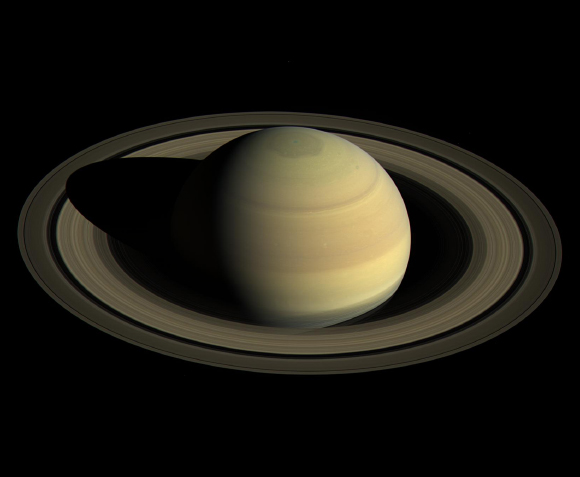The latest images from NASA’s Cassini spacecraft show the northern hemisphere of Solar System’s second-largest planet, as that part of the gas giant nears its summer solstice in May 2017.

This image was taken on April 25, 2016 from a distance of approximately 1.9 million miles (3 million km) from Saturn. The view looks toward the sunlit side of the rings from a Sun-Saturn-spacecraft angle of 55 degrees. Image credit: NASA / JPL-Caltech / Space Science Institute.
Cassini scanned across Saturn and its amazing rings on April 25 to 27, 2016, capturing several sets of images.
The images were obtained using Cassini’s wide-angle camera, a refractor with a focal length of 200 mm and a field of view of 3.5 degrees.
When it began taking images, the robotic orbiter was 1,847,000 miles (2,973,000 km) from Saturn, with an image scale of 221 miles (355 km) per pixel.
When it finished gathering the images, the spacecraft had moved 171,000 miles (275,000 km) closer to the planet, with an image scale of 200 miles (322 km) per pixel.
Cassini mission scientists strung together these images to create a 41-second movie.
This short movie shows just over four Saturnian days (a day on Saturn lasts 10 hours 32 minutes 45 seconds).
Visible at top is the giant hexagon-shaped jet stream that surrounds the north pole of Saturn. Each side of this huge shape is slightly wider than our planet.
After more than twelve years studying Saturn, its rings and moons, Cassini has entered the final year of its epic voyage.
Beginning on November 30, 2016 Cassini’s orbit will send the spacecraft just past the outer edge of the main rings. During these orbits, Cassini will approach to within 4,850 miles (7,800 km) of the center of the narrow F ring, with its peculiar kinked and braided structure.
Cassini’s final phase — called the Grand Finale — begins in earnest in April 2017.
A close flyby of Saturn’s moon Titan will reshape the spacecraft’s orbit so that it passes through the gap between Saturn and the rings – an unexplored space only about 1,500 miles (2,400 km) wide. The spacecraft is expected to make 22 plunges through this gap, beginning with its first dive on April 27.
During the final phase, Cassini will make the closest-ever observations of Saturn, mapping the gas giant’s magnetic and gravity fields with exquisite precision and returning ultra-close views of the atmosphere.
The Grand Finale will come to a dramatic end on September 15, 2017, as Cassini dives into Saturn’s atmosphere, returning data about the planet’s chemical composition until its signal is lost. Friction with the Saturnian atmosphere will cause the spacecraft to burn up like a meteor soon afterward.







